An Analysis of Stormwater Management Variants in Urban Catchments
Abstract
:1. Introduction
2. Materials and Methods
2.1. Case Study
2.2. Storm Water Management Model (SWMM)
2.3. Sustainable Urban Drainage Systems (RETENTION SEWAGE CANAL)
3. Results
4. Discussion
5. Conclusions
Author Contributions
Funding
Acknowledgments
Conflicts of Interest
References
- Słyś, D.; Stec, A. Centralized or Decentralized Rainwater Harvesting Systems: A Case Study. Resources 2020, 9, 5. [Google Scholar] [CrossRef] [Green Version]
- Hu, S.; Fan, Y.; Zhang, T. Assessing the Effect of Land Use Change on Surface Runoff in a Rapidly Urbanized City: A Case Study of the Central Area of Beijing. Land 2020, 9, 17. [Google Scholar] [CrossRef] [Green Version]
- Nations United. The World Population. Available online: https://www.un.org/development/desa/en/news/population/2018-revision-of-world-urbanization-prospects.html (accessed on 13 January 2020).
- Kordana, S. SWOT analysis of wastewater heat recovery systems application. E3S Web Conf. 2017, 17, 00042. [Google Scholar] [CrossRef]
- Sarabi, S.E.; Han, Q.; Romme, A.G.L.; de Vries, B.; Wendling, L. Key Enablers of and Barriers to the Uptake and Implementation of Nature-Based Solutions in Urban Settings: A Review. Resources 2019, 8, 121. [Google Scholar] [CrossRef] [Green Version]
- Guneralp, B.; Lwasa, S.; Masundire, H.; Parnell, S.; Seto, K.C. Urbanization in Africa: Challenges and opportunities for conservation. Environ. Res. Lett. 2018, 13, 015002. [Google Scholar] [CrossRef]
- Papciak, D.; Tchórzewska-Cieślak, B.; Domoń, A.; Wojtuś, A.; Żywiec, J.; Konkol, J. The Impact of the quality of tap water and the properties of installation materials on the formation of biofilms. Water 2019, 11, 1903. [Google Scholar] [CrossRef] [Green Version]
- Tchórzewska-Cieślak, B.; Pietrucha-Urbanik, K.; Papciak, D. An Approach to Estimating Water Quality Changes in Water Distribution Systems Using Fault Tree Analysis. Resources 2019, 8, 162. [Google Scholar] [CrossRef] [Green Version]
- Kaykhosravi, A.; Abogadil, K.; Khan, U.; Jadidi, M. The Low-Impact Development demand index: A new approach to identifying locations for LID. Water 2019, 11, 2341. [Google Scholar] [CrossRef] [Green Version]
- Hornbuckle, J.W.; Christen, E.W.; Faulkner, R.D. Evaluating a multi-level subsurface drainage system for improved drainage water quality. Agric. Water Manag. 2017, 89, 208–216. [Google Scholar] [CrossRef]
- Abbas, O.; Abou Rjeily, Y.; Sadek, M.; Shahrour, I. A large-scale experimentation of the smart sewage system. Water Environ. J. 2017, 31, 515–521. [Google Scholar] [CrossRef]
- Pochwat, K.; Kida, M.; Ziembowicz, S.; Koszelnik, P. Odours in Sewerage-A Description of Emissions and of Technical Abatement Measures. Environments 2019, 6, 89. [Google Scholar] [CrossRef] [Green Version]
- Rodriguez-Sinobas, L.; Zubelzu, S.; Perales-Momparler, S.; Canogar, S. Techniques and criteria for sustainable urban stormwater management. The case study of Valdebebas (Madrid, Spain). J. Cleaner Prod. 2018, 172, 402–416. [Google Scholar] [CrossRef]
- Dziopak, J. A wastewater retention canal as a sewage network and accumulation reservoir. E3S Web Conf. 2018, 45, 00016. [Google Scholar] [CrossRef] [Green Version]
- Bruni, G.; Reinoso, R.; van de Giesen, N.C.; Clemens, F.H.L.R.; ten Veldhuis, J.A.E. On the sensitivity of urban hydrodynamic modelling to rainfall spatial and temporal resolution. Hydrol. Earth Syst. Sci. 2015, 19, 691–709. [Google Scholar] [CrossRef] [Green Version]
- da Silva, C.V.F.; Schardong, A.; Garcia, J.I.B.; Oliveira, C.D.M. Climate change impacts and flood control measures for highly developed urban watersheds. Water 2018, 10, 829. [Google Scholar] [CrossRef] [Green Version]
- Chan, F.K.S.; Griffiths, J.A.; Higgitt, D.; Xu, S.Y.; Zhu, F.F.; Tang, Y.T.; Xu, Y.Y.; Thorne, C.R. "Sponge City" in China-A breakthrough of planning and flood risk management in the urban context. Land Use Policy 2018, 76, 772–778. [Google Scholar] [CrossRef]
- Yue, H.; Li, L.; Yu, Y. Does urban cluster promote the increase of urban eco-efficiency? Evidence from Chinese cities. J. Cleaner Prod. 2018, 197, 957–971. [Google Scholar] [CrossRef]
- Zdeb, M.; Zamorska, J.; Papciak, D.; Słyś, D. The quality of rainwater collected from roofs and the possibility of its economic use. Resources 2020, 9, 12. [Google Scholar] [CrossRef] [Green Version]
- Talib, A.; Randhir, T.O. Climate change and land use impacts on hydrologic processes of watershed systems. J. Water Clim. Change 2017, 8, 363–374. [Google Scholar] [CrossRef]
- Zeleňáková, M.; Hluštík, P.; Abd-Elhamid, H.F.; Vranayová, Z.; Markovič, G.; Hudáková, G.; Tometz, L. Comprehensive study of the percolation of water from surface runoff with an emphasis on the retention capacity and intensity of precipitation. Water Sci. Technol. 2019, 79, 2407–2416. [Google Scholar] [CrossRef]
- Pochwat, K. Hydraulic analysis of functioning of the drainage channel with increased retention capacity. E3S Web Conf. 2017, 17, 00075. [Google Scholar] [CrossRef] [Green Version]
- Todeschini, S.; Papiri, S.; Ciaponi, C. Placement Strategies and Cumulative Effects of Wet-weather Control Practices for Intermunicipal Sewerage Systems. Water Resour. Manag. 2018, 32, 2885–2900. [Google Scholar] [CrossRef]
- Sadeghi, K.M.; Loaiciga, H.A.; Kharaghani, S. Stormwater control measures for runoff and water quality management in urban landscapes. J. Am. Water Resour. Assoc. 2018, 54, 124–133. [Google Scholar] [CrossRef]
- Dietz, M.E.; Clausen, J.C. Stormwater runoff and export changes with development in a traditional and low impact subdivision. J. Environ. Manag. 2008, 87, 560–566. [Google Scholar] [CrossRef] [PubMed]
- Yang, X.H.; Ye, N.; Li, M.S. Comprehensive assessment of low impact development for urban stormwater control measure - a case study of bioretention. Basic Clin. Physiol. Pharmacol. 2016, 119, 30–33. [Google Scholar]
- Buurman, J.; Babovic, V. Adaptation Pathways and Real Options Analysis: An approach to deep uncertainty in climate change adaptation policies. Policy Soc. 2016, 35, 137–150. [Google Scholar] [CrossRef] [Green Version]
- Wang, M.; Zhang, D.Q.; Adhityan, A.; Ng, W.J.; Dong, J.W.; Tan, S.K. Assessing cost-effectiveness of bioretention on stormwater in respons to climate change and urbanization for future scenarios. J. Hydrol. 2016, 543, 423–432. [Google Scholar] [CrossRef]
- Morehouse, B.J.; Carter, R.H.; Tschakert, P. Sensitivity of urban water resources in Phoenix, Tucson, and Sierra Vista, Arizona, to severe drought. Clim. Res. 2002, 21, 283–297. [Google Scholar] [CrossRef] [Green Version]
- March, H.; Domenech, L.; Sauri, D. Water conservation campaigns and citizen perceptions: The drought of 2007-2008 in the Metropolitan Area of Barcelona. Nat. Hazards 2013, 65, 1951–1966. [Google Scholar] [CrossRef]
- Seckler, D.; Barker, R.; Amarasinghe, U. Water scarcity in the twenty-first century. Int. J. Water Resour. Dev. 1999, 15, 29–42. [Google Scholar] [CrossRef]
- Bokal, S.; Grobicki, A.; Kindler, J.; Thalmeinerova, D. From national to regional plans—The Integrated Drought Management Programme of the Global Water Partnership for Central and Eastern Europe. Weather Clim. Extremes 2014, 3, 37–46. [Google Scholar] [CrossRef] [Green Version]
- Grillakis, M.G.; Koutroulis, A.G.; Tsanis, I.K. Improving Seasonal Forecasts for Basin Scale Hydrological Applications. Water 2018, 10, 1593. [Google Scholar] [CrossRef] [Green Version]
- Ghosh, R.; Kansal, A.; Venkatesh, G. Urban Water Security Assessment Using an Integrated Metabolism Approach—Case Study of the National Capital Territory of Delhi in India. Resources 2019, 8, 62. [Google Scholar] [CrossRef] [Green Version]
- Wartalska, K.; Kaźmierczak, B.; Nowakowska, M.; Kotowski, A. Analysis of hyetographs for sewer systems modeling. Water 2020, 12, 149. [Google Scholar] [CrossRef] [Green Version]
- Noblega, A.; Sauri, D.; March, H. Community Involvement in the Implementation of Sustainable Urban Drainage Systems (SUDSs): The Case of Bon Pastor, Barcelona. Sustainability 2020, 12, 510. [Google Scholar] [CrossRef] [Green Version]
- Starzec, M.; Dziopak, J.; Słyś, D. Designing a retention sewage canal with consideration of the dynamic movement of precipitation over the selected urban catchment. In Underground Infrastructure of Urban Areas 4, 4th ed.; Madryas, C., Kolonko, A., Nienartowicz, B., Szot, A., Eds.; CRC Press: London, UK, 2017; Volume 1, pp. 193–200. ISBN 9781138559530. [Google Scholar]
- Stec, A.; Słyś, D. Effect of development of the town of Przemyśl on operation of its sewerage system. Ecol. Chem. Eng. S 2013, 20, 381–396. [Google Scholar] [CrossRef] [Green Version]
- Ngamalieu-Nengoue, U.A.; Martínez-Solano, F.J.; Iglesias-Rey, P.L.; Mora-Meliá, D. Multi-objective optimization for urban drainage or sewer networks rehabilitation through pipes substitution and storage tanks installation. Water 2019, 11, 935. [Google Scholar] [CrossRef] [Green Version]
- Mazzotta, M.J.; Besedin, E.; Speers, A.E. A Meta-Analysis of hedonic studies to assess the property value effects of low impact development. Resources 2014, 3, 31–61. [Google Scholar] [CrossRef]
- Mahmoodzadeh, M.; Mukhopadhyaya, P.; Valeo, C. Effects of extensive green roofs on energy performance of school buildings in four north american climates. Water 2020, 12, 6. [Google Scholar] [CrossRef] [Green Version]
- Kordana, S. The identification of key factors determining the sustainability of stormwater systems. E3S Web Conf. 2018, 45, 00033. [Google Scholar] [CrossRef] [Green Version]
- Cui, T.; Long, Y.; Wang, Y. Choosing the LID for urban storm management in the south of Taiyuan basin by comparing the storm water reduction efficiency. Water 2019, 11, 2583. [Google Scholar] [CrossRef] [Green Version]
- Dong, R.; Zhang, X.; Li, H. Constructing the ecological security pattern for Sponge City: A sase study in Zhengzhou, China. Water 2019, 11, 284. [Google Scholar] [CrossRef] [Green Version]
- Fletcher, T.D.; Shuster, W.; Hunt, W.F.; Ashley, R.; Butler, D.; Arthur, S.; Trowsdale, S.; Barraud, S.; Semadeni-Davies, A.; Bertrand-Krajewski, J.L.; et al. SUDS, LID, BMPs, WSUD and more—The evolution and application of terminology surrounding urban drainage. Urban Water J. 2015, 12, 525–542. [Google Scholar] [CrossRef]
- Ishaq, S.; Hewage, K.; Farooq, S.; Sadiq, R. State of provincial regulations and guidelines to promote low impact development (LID) alternatives across Canada: Content analysis and comparative assessment. J. Environ. Manag. 2019, 235, 389–402. [Google Scholar] [CrossRef]
- Elliott, A.H.; Trowsdale, S.A. A Review of Models for Low Impact Urban Stormwater Drainage. Environ. Model. Softw. 2007, 22, 394–405. [Google Scholar] [CrossRef]
- Coffman, L.S.; Goo, R.; Frederick, R. Low-Impact Development An Innovative Alternative Approach to Stormwater Management. In Proceedings of the 29th Annual Water Resources Planning and Management Conference, Tempe, AZ, USA, 6–9 June 1999; pp. 1–10. [Google Scholar]
- Vogel, J.R.; Moore, T.L.; Coffman, R.R.; Rodie, S.N.; Hutchinson, S.L.; McDonough, K.R.; McLemore, A.J.; McMaine, J.T. Critical Review of Technical Questions Facing Low Impact Development and Green Infrastructure: A Perspective from the Great Plains. Water Environ. Res. 2015, 87, 849–862. [Google Scholar] [CrossRef]
- Johns, C.; Shaheen, F.; Woodhouse, M. Green Infrastructure and Stormwater Management in Toronto: Policy Context and Instruments, Centre for Urban Research and Land Development; Centre for Urban Research and Land Development: Toronto, ON, Canada, 2018. [Google Scholar]
- Moore, T.L.C.; Hunt, W.F. Ecosystem service provision by stormwater wetlands and ponds—A means for evaluation? Water Res. 2012, 46, 6811–6823. [Google Scholar] [CrossRef]
- Hassall, C.; Anderson, S. Stormwater ponds can contain comparable biodiversity to unmanaged wetlands in urban areas. Hydrobiologia 2015, 745, 137–149. [Google Scholar] [CrossRef]
- Taylor, J.R.; Lovell, S.T. Urban home food gardens in the Global North: Research traditions and future directions. Agric. Hum. Values 2014, 31, 285–305. [Google Scholar] [CrossRef]
- Hostetler, M.; Allen, W.; Meurk, C. Landscape and Urban Planning Conserving urban biodiversity? Creating green infrastructure is only the first step. Landsc. Urban Plan. 2011, 100, 369–371. [Google Scholar] [CrossRef]
- Pinho, P.; Correia, O.; Lecoq, M.; Munzi, S.; Vasconcelos, S.; Gonçalves, P.; Rebelo, R.; Antunes, C.; Silva, P.; Freitas, C.; et al. Evaluating green infrastructure in urban environments using a multi-taxa and functional diversity approach. Environ. Res. 2016, 147, 601–610. [Google Scholar] [CrossRef] [PubMed]
- Mao, X.; Jia, H.; Yu, S.L. Assessing the ecological benefits of aggregate LID-BMPs through modelling. Ecol. Model. 2017, 353, 139–149. [Google Scholar] [CrossRef]
- Schifman, L.A.; Prues, A.; Gilkey, K.; Shuster, W.D. Realizing the opportunities of black carbon in urban soils: Implications for water quality management with green infrastructure. Sci. Total Environ. 2018, 644, 1027–1035. [Google Scholar] [CrossRef] [PubMed]
- Xie, N.; Akin, M.; Shi, X. Permeable concrete pavements: A review of environmental benefits and durability. J. Clean. Prod. 2019, 210, 1605–1621. [Google Scholar] [CrossRef]
- Seo, M.; Jaber, F.; Srinivasan, R.; Jeong, J. Evaluating the Impact of Low Impact Development (LID) Practices on Water Quantity and Quality under Different Development Designs Using SWAT. Water 2017, 9, 193. [Google Scholar] [CrossRef]
- Capotorti, G.; Alós Ortí, M.M.; Copiz, R.; Fusaro, L.; Mollo, B.; Salvatori, E.; Zavattero, L. Biodiversity and ecosystem services in urban green infrastructure planning: A case study from the metropolitan area of Rome (Italy). Urban For. Urban Green. 2019, 37, 87–96. [Google Scholar] [CrossRef]
- Morakinyo, T.E.; Lam, Y.F.; Hao, S. Evaluating the role of green infrastructures on near-road pollutant dispersion and removal: Modelling and measurement. J. Environ. Manag. 2016, 182, 595–605. [Google Scholar] [CrossRef]
- Nordbo, A.; Järvi, L.; Haapanala, S.; Wood, C.R.; Vesala, T. Fraction of natural area as main predictor of net CO2 emissions from cities. Geophys. Res. Lett. 2012, 39. [Google Scholar] [CrossRef]
- Chenoweth, J.; Anderson, A.R.; Kumar, P.; Hunt, W.F.; Chimbwandira, S.J.; Moore, T.L.C. The interrelationship of green infrastructure and natural capital. Land Use Policy 2018, 75, 137–144. [Google Scholar] [CrossRef]
- Rafael, S.; Vicente, B.; Rodrigues, V.; Miranda, A.I.; Borrego, C.; Lopes, M. Impacts of green infrastructures on aerodynamic flow and air quality in Porto’s urban area. Atmos. Environ. 2018, 190, 317–330. [Google Scholar] [CrossRef]
- Jayasooriya, V.M.; Ng, A.W.M.; Muthukumaran, S.; Perera, B.J.C. Green infrastructure practices for improvement of urban air quality. Urban For. Urban Green. 2017, 21, 34–47. [Google Scholar] [CrossRef]
- Wang, Y.; Sun, M.; Song, B. Public perceptions of and willingness to pay for sponge city initiatives in China. Resour. Conserv. Recycl. 2017, 122, 11–20. [Google Scholar] [CrossRef]
- Ministry of Housing and Urban-Rural Development. The Constructionguideline of Sponge City in China—Low Impact Development of Stormwater System(trail); Ministry of Housing and Urban-Rural Development: Beijing, China, 2014.
- Benzerra, A.; Cherrared, M.; Chocat, B.; Cherqui, F.; Zekiouk, T. Decision support for sustainable urban drainage system management: A case study of Jijel, Algieria. J. Environ. Manag. 2012, 101, 46–53. [Google Scholar] [CrossRef] [PubMed]
- Bogdanowicz, E.; Stachy, J. Maximum Rainfall in Poland. Design Characteristics, 1st ed.; The Publishing House of the Institute of Meteorology and Water Management: Warsaw, Poland, 1998; p. 83. [Google Scholar]
- Rossman, L.A. Storm Water Management Model User’s Manual Version 5.1. United States Environmental Protection Agency. Available online: https://www.epa.gov/water-research/storm-water-management-model-swmm (accessed on 13 January 2020).
- Słyś, D. An innovative retention canal—A case study. E3S Web Conf. 2018, 45, 00084. [Google Scholar] [CrossRef] [Green Version]
- Słyś, D.; Dziopak, J. Retention Sewage Canal; Patent Office of the Republic of Poland: Warsaw, Poland, 2014; p. 217405. [Google Scholar]
- Starzec, M. The impact of construction of piling partitions on the retention efficiency of a sewerage network. E3S Web Conf. 2018, 45, 00087. [Google Scholar] [CrossRef] [Green Version]
- Xia, J.; Zhang, Y.; Xiong, L.; He, S.; Wang, L.; Yu, Z. Opportunities and challenges of the Sponge City construction related to urban water issues in China. Sci. China Earth Sci. 2017, 60, 652–658. [Google Scholar] [CrossRef]
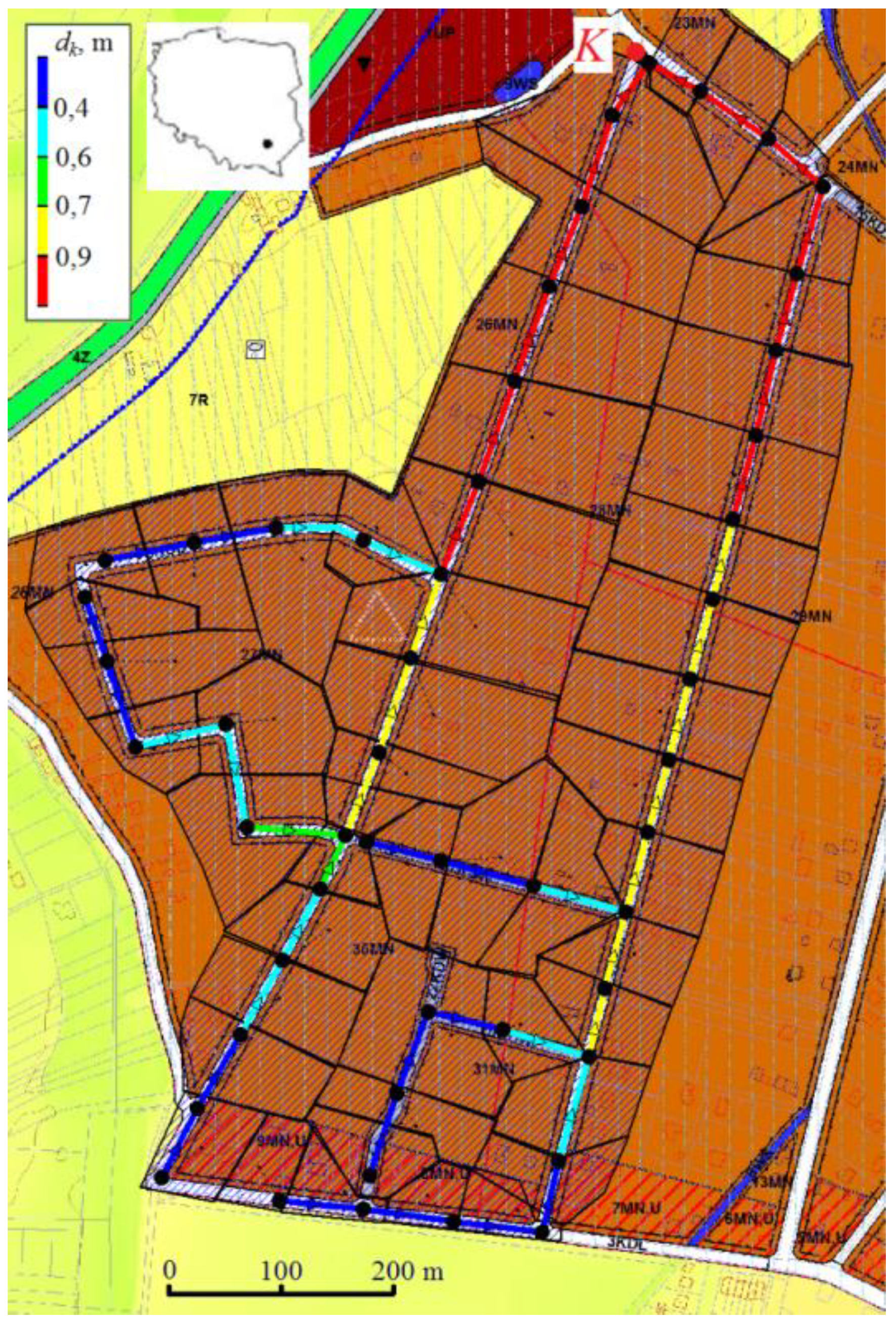
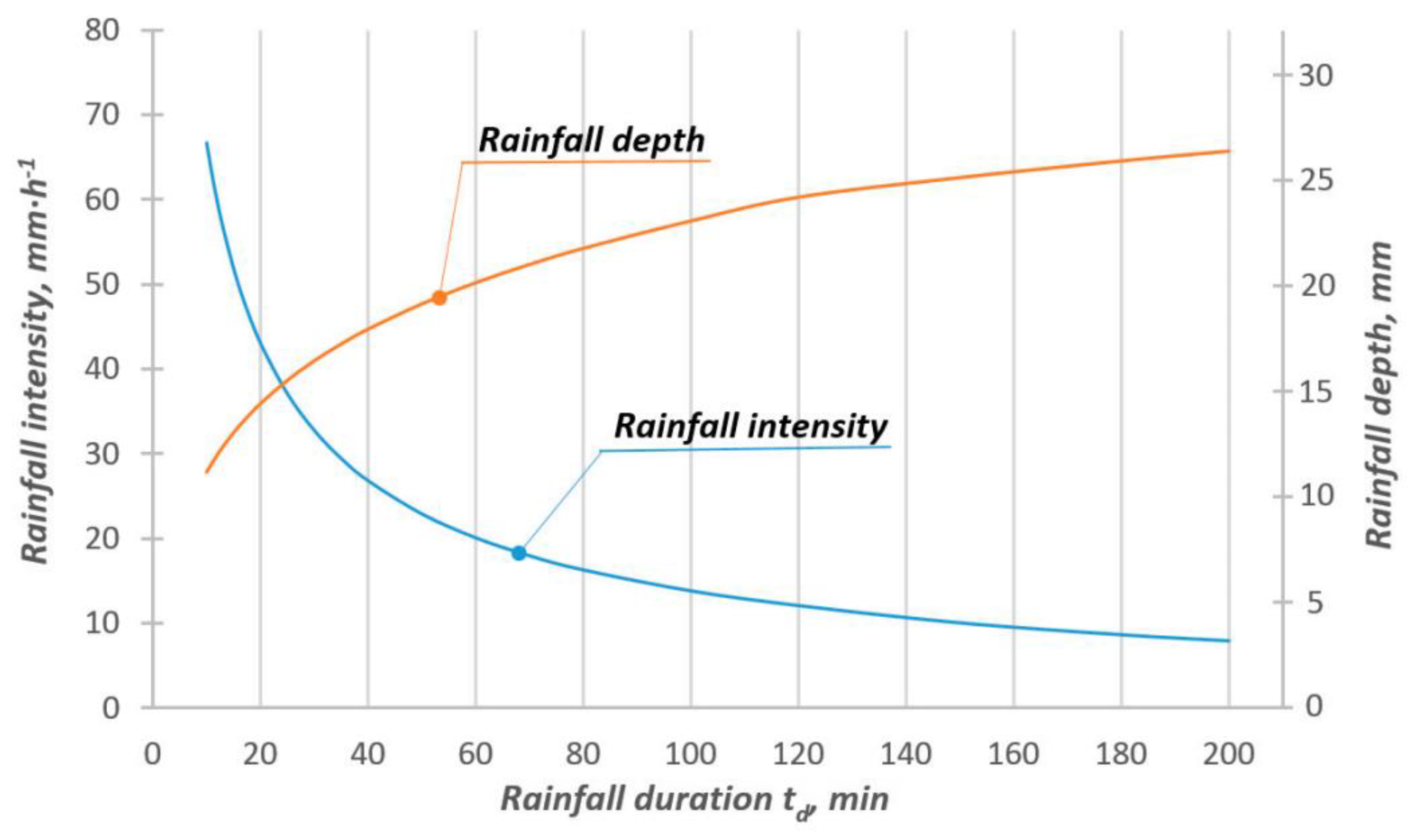
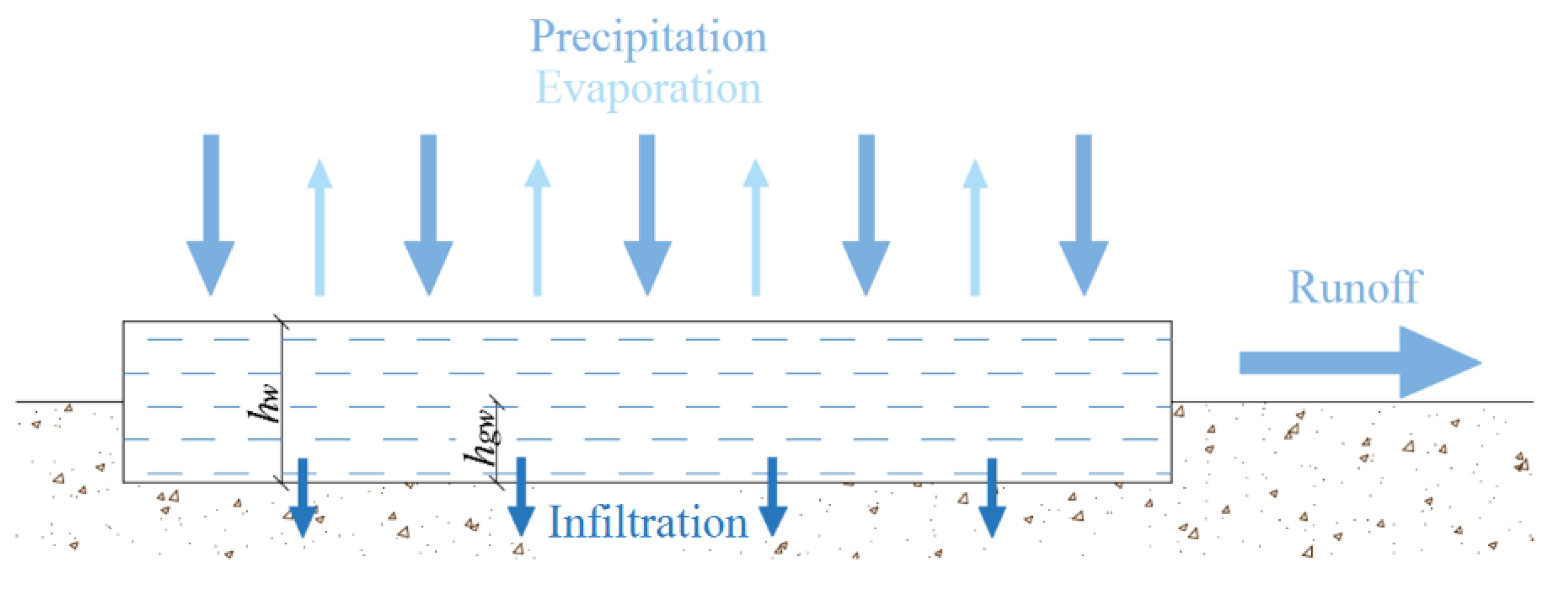



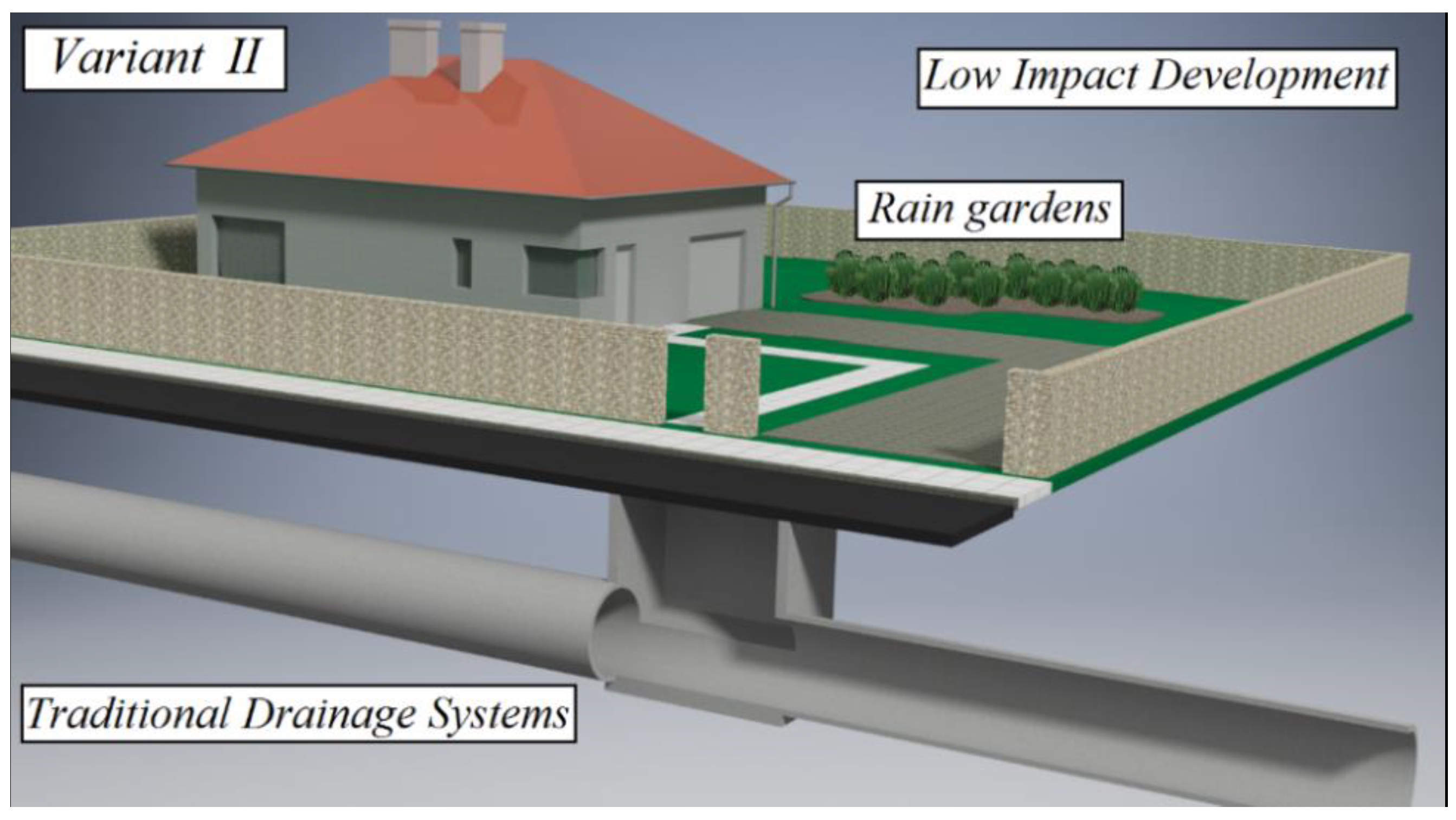
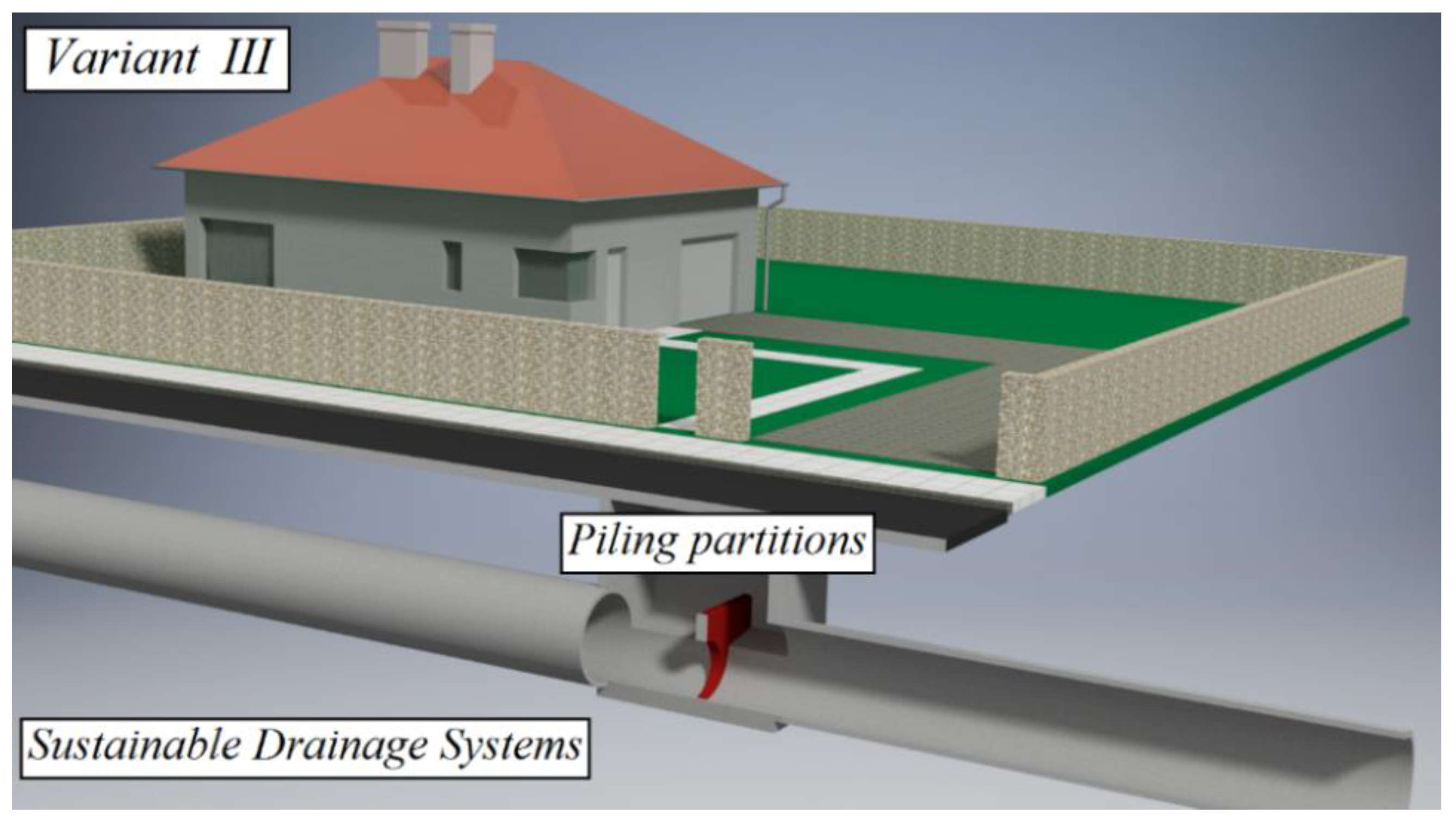
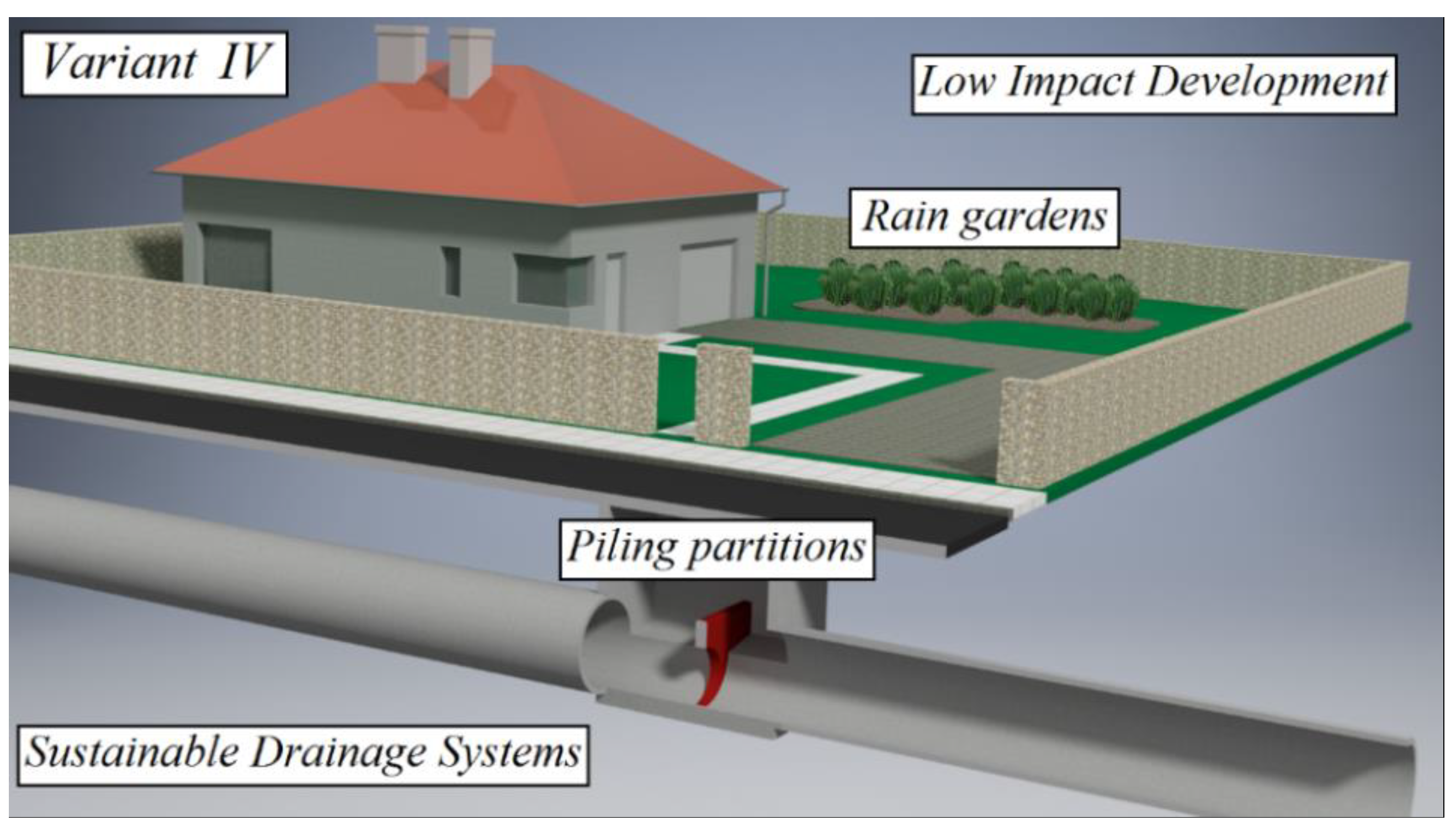

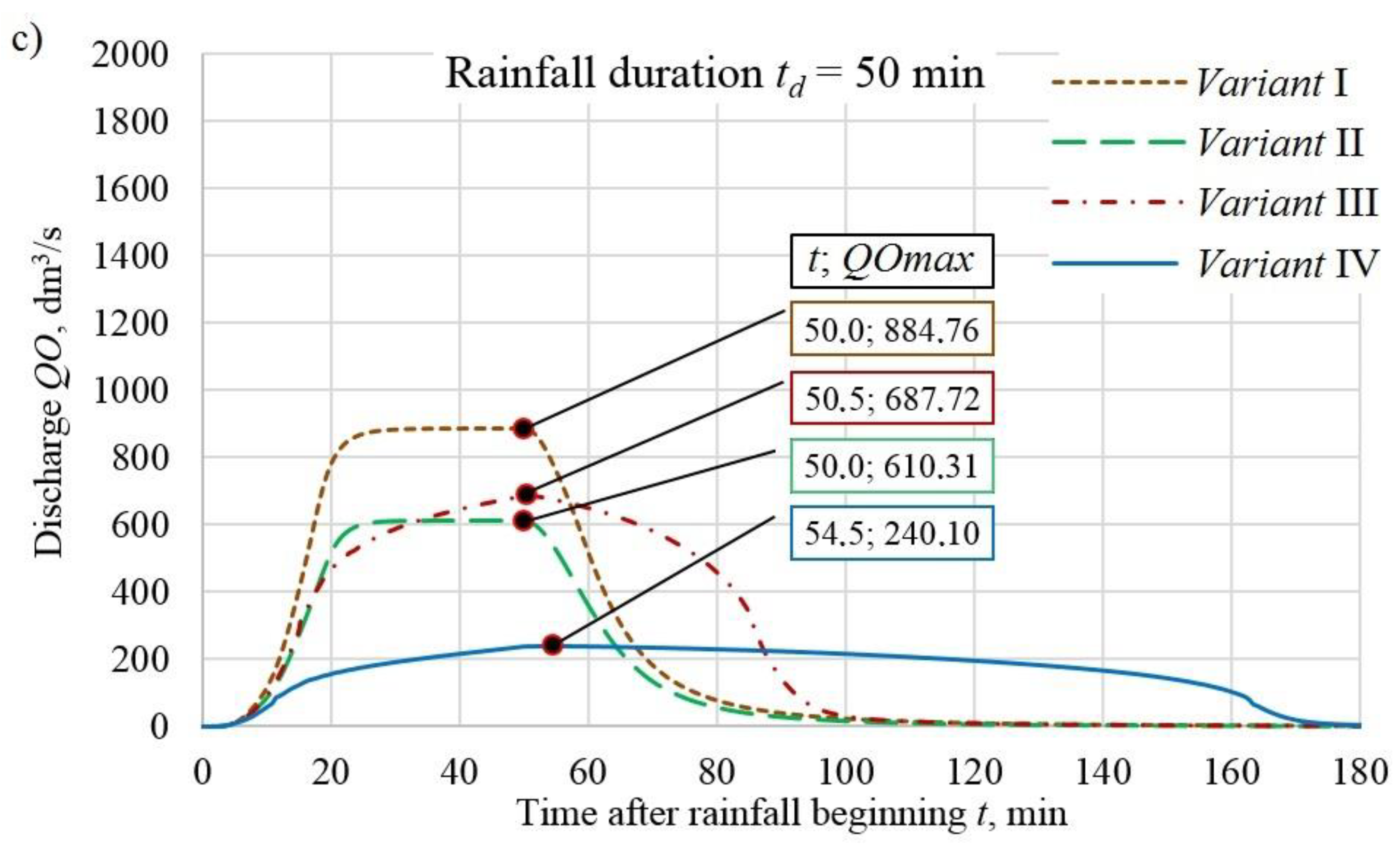

| Land Use | Area | |
|---|---|---|
| (ha) | (%) | |
| Rooftop | 4.78 | 10.30 |
| Road, pavement and other impervious | 9.60 | 20.70 |
| Green area | 32.00 | 69.00 |
| Total areas | 46.38 | 100.00 |
| Parameter | Value | |
|---|---|---|
| Minimum | Maximum | |
| Length of links | 19.36 m | 97.40 m |
| Total length of links | 3769.70 m | |
| Slope of links Diameter of links | 1.1 ‰ 0.3 m | 3.1 ‰ 1.0 m |
| Drainage system capacity | 1515.76 m3 | |
| Layers | Value |
|---|---|
| Surface layer | |
| Berm height | 80 mm |
| Vegetation volume fraction | 0.1 (volume fraction) |
| Surface roughness (Manning n) | 0.052 m −1/3s |
| Surface slope | 1.0% |
| Soil layer | |
| Thickness | 900 mm |
| Porosity | 0.33 (volume fraction) |
| Field capacity | 0.24 (volume fraction) |
| Wilting point | 0.15 (volume fraction) |
| Conductivity | 10 mm/h |
| Conductivity slope | 1 |
| Suction head | 5 mm/h |
| Variant | Advantages | Disadvantages |
|---|---|---|
| I | -Minimal demand for built-up space, especially on the land surface. -High resistance to adverse soil and water conditions. -No requirements regarding the quality of transported stormwater. -Can be used in areas with different buildings -Possibility of using trenchless methods during the investment. | -Lack of utilization of retention capabilities of active channels in these systems. -Adverse hydrograph of rainwater runoff from the system (cumulative peak rainfall discharges to the receiver). -The entire volume of rainwater transported by the system is discharged outside the drainage basin. -Deterioration of the receiver’s water quality by introducing impurities contained in rainwater. |
| II | -Ability to temporarily rainwater retention. Possibility of interoperability of LID devices with other drainage infrastructure. -Limiting the volume of stormwater discharged outside the drainage basin. -Improvement of soil and water conditions in the catchment area. -Imitation of natural hydrological processes before urbanization. -Rainwater pretreatment. -Possibility of rainwater supply by existing traditional sewage systems. -Possibility of cooperation of various LID objects within the drained drainage basin. -Improving the diversity of urban ecosystems, including providing new habitats for a wider range of organisms. -Recreation space and improvement of the utility value of a district or urban areas. | -Frequent necessity of pre-treatment of rainwater before it is fed to soil infiltration devices. -The need for periodic maintenance of LID devices. -Dependence on soil and water conditions -Dependence on area availability. -A significant share of the required area of LID facilities in relation to the drained drainage basin. -Often possible high investments. |
| III | -All benefits of Variant I. -Using the retention possibilities of existing drainage systems. -A favorable hydrograph of rainwater outflow from the system (low and constant rainfall outflow intensity). - The possibility of applying various LID objects to the drainage system. | -The entire volume of rainwater transported by the system is discharged outside the drainage basin. -Reduction of the load per unit load of the receiver’s water pollution. -Deterioration of the receiver’s water quality by introducing impurities contained in rainwater. -Dependence of the retention capacity of the drainage system on the average bottom of its ducts, equipped with retention canals. |
| IV | - Benefits of Variants II and III. - The maximum possible reduction of the peak outflow from the drained drainage basin. - The possibility of limiting the use of LID facilities in places where their operation is expensive and/or difficult to implement. - Limitation of the required geometry of drainage system, especially in areas with permeable soils. | -Frequent necessity of pre-treatment of rainwater supplied to devices before infiltration into the ground. -Periodic maintenance of LID devices is required. -Dependence on soil and water conditions for LID facilities. -Dependence on the availability of land for the construction of LID facilities. |
© 2020 by the authors. Licensee MDPI, Basel, Switzerland. This article is an open access article distributed under the terms and conditions of the Creative Commons Attribution (CC BY) license (http://creativecommons.org/licenses/by/4.0/).
Share and Cite
Starzec, M.; Dziopak, J.; Słyś, D. An Analysis of Stormwater Management Variants in Urban Catchments. Resources 2020, 9, 19. https://doi.org/10.3390/resources9020019
Starzec M, Dziopak J, Słyś D. An Analysis of Stormwater Management Variants in Urban Catchments. Resources. 2020; 9(2):19. https://doi.org/10.3390/resources9020019
Chicago/Turabian StyleStarzec, Mariusz, Józef Dziopak, and Daniel Słyś. 2020. "An Analysis of Stormwater Management Variants in Urban Catchments" Resources 9, no. 2: 19. https://doi.org/10.3390/resources9020019
APA StyleStarzec, M., Dziopak, J., & Słyś, D. (2020). An Analysis of Stormwater Management Variants in Urban Catchments. Resources, 9(2), 19. https://doi.org/10.3390/resources9020019







